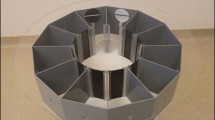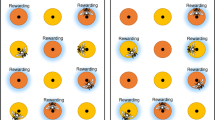Abstract
Bumblebees were exposed to a discrimination procedure in which reinforcement was contingent on choice of one of two spatial locations. The correct choice depended on whether a stimulus display contained two identical stimuli or two different stimuli. Some bees were trained with color stimuli and tested with line grating stimuli and others with the opposite arrangement. Four colonies of bumblebees produced more correct than incorrect choices to both identical and different stimuli during the transfer phase. This pattern of results is a signature of choices under control of an identity (“same/different”) concept. The results therefore indicate the existence of an identity concept in bumblebees.





Similar content being viewed by others
References
Blaisdell AP, Cook RG (2005) Two-item same-different concept learning in pigeons. Learn Behav 33:67–77. doi:10.3758/BF03196051
Bodily KD, Katz JS, Wright AA (2008) Matching-to-sample abstract-concept learning by pigeons. J Exp Psychol Anim B 34:178–184. doi:10.1037/0097-7403.34.1.178
Bovet D, Vauclair J (2001) Judgment of conceptual identity in monkeys. Psychon B Rev 8:470–475. doi:10.3758/BF03196181
Brown MF, Demas GE (1994) Evidence for spatial working memory in honeybees (Apis mellifera). J Comp Psychol 108:344–352. doi:10.1037/0735-7036.108.4.344
Brown MF, McKeon D, Curley T, Weston B, Lambert C, Lebowitz B (1998) Working memory for color in honeybees. Anim Learn Behav 26:264–271. doi:10.3758/BF03199220
Castro L, Kennedy PL, Wasserman EA (2010) Conditional same-different discrimination by pigeons: acquisition and generalization to novel and few-item displays. J Exp Psychol Anim B 36:23–38. doi:10.1037/a0016326
Chittka L, Jensen K (2011) Animal cognition: concepts from apes to bees. Curr Biol 21:R116–R119. doi:10.1016/j.cub.2010.12.045
Chittka L, Thomson JD, Waser NM (1999) Flower constancy, insect psychology, and plant evolution. Naturwissenschaften 86:361–377. doi:10.1007/s001140050636
Collett TS (2005) Invertebrate memory: honeybees with a sense of deja vu. Curr Biol 15:R419–R421. doi:10.1016/j.cub.2005.05.033
Cook RG (2002) The structure of pigeon multiple-class same-different learning. J Exp Anal Beh 78:345–364. doi:10.1901/jeab.2002.78-345
Cook RG, Wasserman EA (2006) Relational discrimination learning in pigeons. In: Wasserman EA, Zentall TR (eds) Comparative cognition: experimental explorations of animal intelligence. Oxford University Press, New York, pp 307–324
Demas GE, Brown MF (1995) Honeybees are predisposed to win-shift but can learn to win-stay. Anim Behav 50:1041–1045. doi:10.1016/0003-3472(95)80104-9
Flemming TM, Beran MJ, Washburn DA (2007) Disconnect in concept learning by rhesus monkeys (Macaca mulatta): judgment of relations and relations-between-relations. J Exp Psychol Anim B 33:55–63. doi:10.1037/0097-7403.33.1.55
French RM (1995) The subtlety of sameness: a theory and computer model of analogy-making. MIT Press, Cambridge
Gentner D, Holyoak KJ, Kolano JW (2001) The analogical mind: perspectives from cognitive science. MIT Press, Cambridge
Giurfa M, Zhang SW, Jenett A, Menzel R, Srinivasan MV (2001) The concepts of ‘sameness’ and ‘difference’ in an insect. Nature 410:930–933. doi:10.1038/35073582
Hölldobler B, Wilson EO (2009) The superorganism: the beauty, elegance, and strangeness of insect societies. Norton, New York
James W (1890) The principles of psychology. Holt, New York
Katz JS, Wright AA (2006) Same/different abstract-concept learning by pigeons. J Exp Psychol Anim B 32:80–86. doi:10.1037/0097-7403.32.1.80
Katz JS, Wright AA, Bachevalier J (2002) Mechanisms of same/different abstract-concept learning by rhesus monkeys (Macadca mulatta). J Exp Psychol Anim B 28:358–368. doi:10.1037//0097-7403.28.4.358
Katz JS, Wright AA, Bodily KD (2007) Issues in the comparative cognition of abstract-concept learning. Comp Cogn Behav Rev 2:79–92. doi:10.3819/ccbr.2008.20005
Lazareva OF, Wasserman EA (2008) Categories and concepts in animals. In: Menzel R (ed) Learning theory and behavior. Elsevier, Oxford, pp 197–226
Mercado E, Killebrew DA, Pack AA, Macha B, Herman LM (2000) Generalization of ‘same-different’ classification abilities in bottlenosed dolphins. Behav Process 50:79–94. doi:10.1016/S0376-6357(00)00100-5
Murphy GL (2002) The big book of concepts. MIT, Cambridge
Nakagawa E (1993) Matching and nonmatching concept-learning in rats. Psychobiol 21:142–150
Ohyama T, Couvillon PA, Bitterman ME (1995) Perseveration in the color choices of honeybees. J Insect Behav 8:409–415. doi:10.1007/BF01989368
Penn DC, Holyoak KJ, Povinelli DJ (2008) Darwin’s mistake: explaining the discontinuity between human and nonhuman minds. Behav Brain Sci 31:109–178. doi:10.1017/S0140525X08003543
Pepperberg IM (1987) Acquisition of the same different concept by an african gray parrot (psittacus-erithacus)—learning with respect to categories of color, shape, and material. Anim Learn Behav 15:423–432. doi:10.3758/BF03205051
Premack D (1983) The codes of man and beasts. Behav Brain Sci 6:125–137. doi:10.1017/S0140525X00015181
Raine NE, Chittka L (2007) Flower constancy and memory dynamics in bumblebees (Hymenoptera: apidae: bombus). Entomol Gen 29:179–199
Raine NE, Chittka L (2008) The correlation of learning speed and natural foraging success in bumble-bees. Proc R Soc B 275:803–808. doi:10.1098/rspb.2007.1652
Raine NE, Ings TC, Dornhaus A, Saleh N, Chittka L (2006) Adaptation, genetic drift, pleiotropy, and history in the evolution of bee foraging behavior. Adv Study Behav 36:803–808. doi:10.1016/S0065-3454(06)36007-X
Riley DA (1968) Discrimination learning. Allyn and Bacon, Boston
Schmidtke KA, Katz JS, Wright AA (2010) Differential outcomes facilitate same/different concept learning. Anim Cogn 13:583–589. doi:10.1007/s10071-009-0292-2
Smith EE, Medin DL (1981) Categories and concepts. Harvard University Press, Cambridge
Wasserman EA, Young ME (2010) Same-different discrimination: the keel and backbone of thought and reasoning. J Exp Psychol Anim B 36:3–22. doi:10.1037/a0016327
Wright AA, Katz JS (2006) Mechanisms of same/different concept learning in primates and avians. Behav Process 72:234–254. doi:10.1016/j.beproc.2006.03.009
Wright AA, Katz JS (2007) Generalization hypothesis of abstract-concept learning: learning strategies and related issues in macaca mulatta, cebus apella, and columba livia. J Comp Psychol 121:387–397. doi:10.1037/0735-7036.121.4.387
Wright AA, Katz JS (2009) A case for restricted-domain relational learning. Psychon Bull Rev 16:907–913. doi:10.3758/PBR.16.5.907
Wright AA, Rivera JJ, Katz JS, Bachevalier J (2003) Abstract-concept learning and list-memory processing by capuchin and rhesus monkeys. J Exp Psychol Anim B 29:184–198. doi:10.1037/0097-7403.29.3.184
Young ME, Wasserman EA (1997) Entropy detection by pigeons: response to mixed visual displays after same–different discrimination training. J Exp Psychol Anim B 23:157. doi:10.1037/0097-7403.23.2.157
Zentall TR, Wasserman EA, Lazareva OF, Thompson RRK, Ratterman MJ (2008) Concept learning in animals. Comp Cogn Behav Rev 3:13–45. doi:10.3819/ccbr.2008.30002
Zhang SW, Bock F, Si A, Tautz J, Srinivasan MV (2005) Visual working memory in decision making by honey bees. Proc Natl Acad Sci USA 102:5250–5255. doi:10.1073/pnas.0501440102
Acknowledgments
This research was supported in part by a Faculty Summer Research Grant from Villanova University. Data from two of the bee colonies were included in the M.S. thesis of Justin Sayde, who is currently at Tufts University.
Author information
Authors and Affiliations
Corresponding author
Rights and permissions
About this article
Cite this article
Brown, M.F., Sayde, J.M. Same/different discrimination by bumblebee colonies. Anim Cogn 16, 117–125 (2013). https://doi.org/10.1007/s10071-012-0557-z
Received:
Revised:
Accepted:
Published:
Issue Date:
DOI: https://doi.org/10.1007/s10071-012-0557-z




